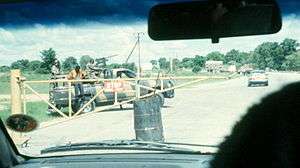Trans-Caprivi highway

The Trans-Caprivi highway opened in 1999 runs from Rundu, in north eastern Namibia, along the Caprivi Strip to Katima Mulilo on the Zambezi River which forms the border between Namibia and Zambia. The Katima Mulilo Bridge spans the river to the Zambian town of Sesheke from where a recently upgraded paved road runs to Livingstone joining the main southern highway to Lusaka, connecting onwards to the Copperbelt.
The Trans-Caprivi highway is a section of the Walvis Bay Corridor, a trade route linking land-locked Zambia (and neighbouring countries such as DR Congo, Malawi and Zimbabwe) to the Walvis Bay port on the Atlantic Ocean. An example of the function of the corridor as a trade route is that trucks carry copper ore concentrate from the Dikulushi Mine in South-East DR Congo across Zambia and down the Trans-Caprivi highway to the copper smelter at Tsumeb in Namibia. The refined copper is then exported from Namibian ports.
Although situated in southern Africa, the Trans-Caprivi highway is part of the most northerly paved highway route linking the Atlantic and Indian Oceans. Between the North African coast road running along the Mediterranean Sea from Egypt to Morocco on the one hand (which cannot be driven continuously; the Morocco-Algeria border is closed), and the Trans-Caprivi highway and the roads linking it to the east coast on the other side (a span of about 5700 km), there are no paved highways crossing the African continent between east and west.
See also
References
- Namport (National Ports Authority of Namibia) website accessed 16 February 2007.
- African Development Bank/United Nations Economic Commission For Africa: "Review of the Implementation Status of the Trans African Highways and the Missing Links: Volume 2: Description of Corridors". August 14, 2003. Retrieved 14 July 2007.
- Michelin Motoring and Tourist Maps: "955: Africa Central and South" (2000), "953: Africa North and West" (1996), "954 Africa North-East and Arabia" (1998). Michelin Travel Publications, Paris.
| ||||||||||